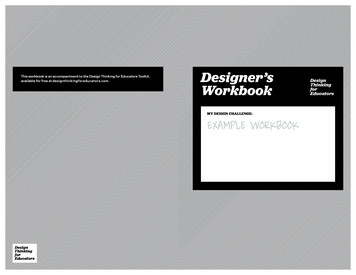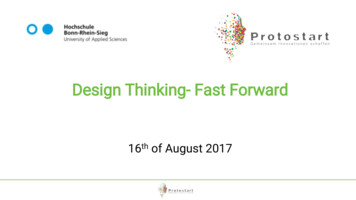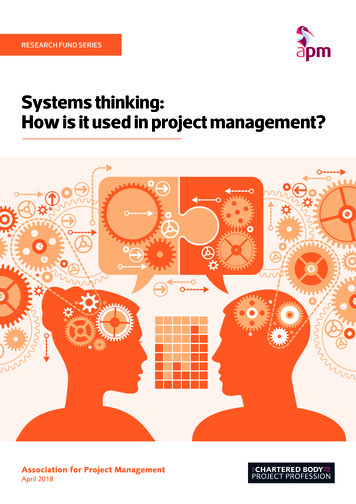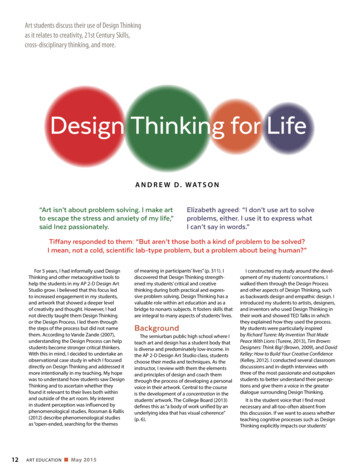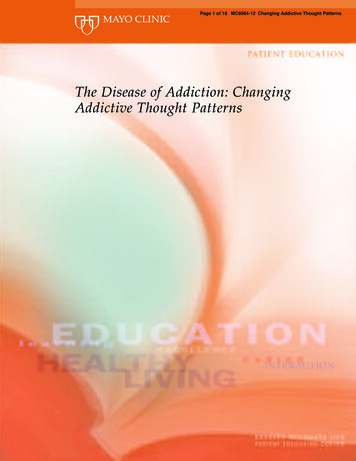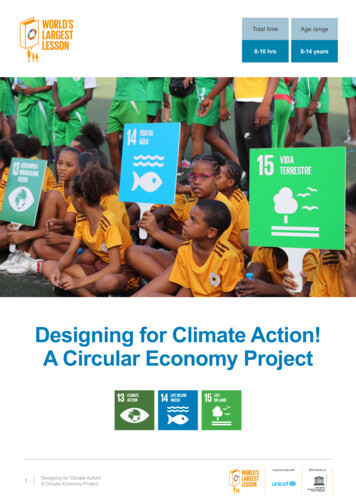
Transcription
Total timeAge range8-10 hrs8-14 yearsDesigning for Climate Action!A Circular Economy ProjectIn partnership with1Designing for Climate Action!A Circular Economy ProjectWith thanks to
World Largest Lesson has developed these resources and included recentlydeveloped design tools from the Delft University of Technology and partners.You can find more information on Your Turn toolbox following this link.The design skills that we defined for assessment were based on a toolkit for formative assessment“Make Design Learning Visible” that will be published in 2021, also from TU Delft and partners.With very many thanks to Miroslava Silva, Remke Klapwijk and the International School of Delft for resourcesupport and creation.Note to Educators:Welcome to World’s Largest Lesson’s Design Thinking Project, created in partnership withTU Delft University of the Netherlands.We hope you enjoy this project, which has been designed to last approx 10 hours. In it, students will be introducedto Design Thinking and the Design Skills they will employ when creating their innovations. At the end of the project,students are encouraged to host a Science Fair, where they can showcase their innovations to parents and otherschool community members. However, in light of COVID-19 restrictions, this may not be possible and you willneed to follow your local school and government advice.The Design Thinking Project is split into 10 activities, following the 6 stages of the Design Thinking Cycle below. Ifthis is the first-time using Design Thinking with your students, they may find it slightly harder to begin with.However, the more you are able to repeat the process with your students, the more familiar they will become withthe language of Design Thinking.If you are using virtual teaching then we have created an online digital portfolio for your students to use.If you have any questions or comments, please let us know at lesson@project-everyone.orgLearningGoal: T o understand how students can take climate action using the circular economy Students will host a school fair where they can offer repurposed products to the school community.Learning outcomes: T o identify the characteristics of the circular economy To answer the design question;“How can I reuse an object in a different way for the well-being of the people in my community?” To design a circular economy project To present their design project at a school or local event To understand why designing for the circular economy is a positive climate actionRequired Resources:Key Language: Classroom with chairs and desks. Laptop Projector Sticky notes Whiteboard or flipchart Colored and white paper Pencils Crayons or markers White board markers Environment Society Economy Non-recyclable Global Goals Climate change Circular economy Reduce Refuse Refurbish Remanufacture Repurpose Repair products Reuse RecycleIn partnership with2Designing for Climate Action!A Circular Economy ProjectWith thanks to
An Overview of the Design Thinking ProjectActivityDesign stepDescription- worksheetTime1Kick-off introduce designproblemIntroduction of the designproject & to identify whothey are designing for60 min2Exploring and formulating theproblemInterview school communitywith reused/repurposed objectsthat they would like to see inthe school fair60 min3Generating ideasBrainstorm ideas to designtheir project using the imagebrainstorm worksheet60 min4Selecting ideasSelect the design idea usingthe C-Box worksheet30 min5Conceptualizing Design IdeasWorking to further conceptualisetheir design idea30 min6Present and feedbackPresent it to the class and takefeedback on how to improve it60 min7SMART prototypingPlan and create a prototypefor their project - Prototypeworksheet60 min8Testing the PrototypeStudents work to updateand amend their prototypes30 min9Pitch Your DesignParticipate in a school fair90 min10Self- AssessmentFormative assessment30 minIn partnership with3Designing for Climate Action!A Circular Economy ProjectWith thanks to
An Explanation of the Design Thinking approachDesign thinking supports giving children their voice, choice and ownership of solutions they come up with basedon real problems. This enhances their knowledge and 21st century skills to participate proactively in society.The students follow a series of the design cycle steps:STEPDesign stepDescriptionExploring and formulating theproblemAs designers they will try to know as much as possible aboutthe problem, the design question should be clear to designthe solution.Generating and selecting ideasAs designers they will brainstorm as many ideas as possibleto find a solution to the problem. The more the better! Thenthey need to decide which idea best answers the designquestion.Generating and selectingconceptsThe concepts are further developed into drafts. The designerthinks about how it looks, how it works and the use ofdifferent materials.Building a prototypeThe design is further developed into a prototype. Thepurpose of the prototype is to be able to test the design.Testing and optimizingThe prototype is tested. If possible, the end user is involved.Testing can be with the complete product or service or just apart of it.PresentingThe design is presented. However, this does not necessarilymean that the design is finished. After this the design couldcontinue to be improved.In partnership with4Designing for Climate Action!A Circular Economy ProjectWith thanks to
Activity 1 – 60 minsLearning Objective:Explore and formulate the problemActivate prior knowledge and prepare students for new concepts and skills related to circulareconomy and climate action.Design skill:Develop empathyWe are learning to empathize with othersThink in all directions (Thinkers)We are learning how to generate many diverse and original ideas by associating and imagining.Instructions:1.NB: This teacher’s guide corresponds with the deck here:Slide23-567DescriptionName of the lesson and introducing the design cycleLearning objectives and big picture of design cycleThey can listen to this podcast as an introduction to design thinking.The activity is to explore their environment and spot something new that they haven’t 89329569The student will answer a self-assessments worksheet that will help them to understand therubrics of what they will learning during the design project.Bring different objects from home and school and ask themWhich of these objects do you think could be? reused regifted refuse to use if it’s a single use object recycled repaired remanufactured repurposed biodegradedIn partnership with5Designing for Climate Action!A Circular Economy ProjectWith thanks to
8Show the photo and ask students to brainstorm what they could make from the objects in theimage.Explain to students that in this unit we are going to learn about the circular economy. What mightthis mean?Explain that the purpose of this lesson will be thinking about this question:9How can I reuse, repair or repurpose an object for the wellbeing of people from my schoolcommunity?Watch the circular economy video: https://www.youtube.com/watch?v A5wn iinbxwDiscuss what they understand as the circular economy after watching the video. How doesdesigning for the circular economy help to fight climate change?10Introduce the design question and explain that in this project we will be focusing on:Reuse/ Repair/RepurposeExplain that in the following lessons they will design something answering this question:How can I reuse an object in a different way for the wellbeing of the people in mycommunity?11Ask students to make a link to the Global Goals. How could answering this question also help toachieve the Global Goals? Why might it help them to tackle Goal 13 Climate Action?12Explain that their design is for a specific group of users that share similar characteristics.Students then decide which group they will be designing for: e.g. teachers/parents/students/babies/their year group.1314Create a persona to help students identify with the end user. The students have to imagine, drawand describe a fictional person using all the details from the “Persona” worksheet.Use the worksheet of the persona and answer the following questions: Where does he/she live? What does he/she like to do? What does he/she not like doing? Any fun facts about your persona? What does he/she hope to do? What does he/she struggle with? – Link to the design problemExample of personaLearning evidence: Teams of two or three students make the persona.In partnership with6Designing for Climate Action!A Circular Economy ProjectWith thanks to
Activity 2 – 60 minsLearning Objective:Generating and selecting ideas.Interview school communities with circular economy ideas they would like to see in the school fair.Design skillsThink in all directionsWe are learning how to generate many diverse and original ideas by combining associating andimagining.Make ideas tangibleWe are learning how to elaborate ideas and thoughts using a variety of tools such as stories,drawings, models and prototypes.Develop empathyWe are learning to empathize with others by experiencing the problem, investigate the user’scontext and actively seeking input and feedback.Instructions:SlideDescription15-16Explain the purpose of this lesson.Read out the learning objectives with students and go through the design skills they will be using.17Explain to students that we are going to interview some adults/other children to understand howwe could help answer the Design Question.We are going to ask them: “What could I design with reused materials to make your life better?”18Students make a list of things that can be reused, repurposed or repaired and ask people similarto their persona if they like it or not19Were there any examples that kept reoccurring? Students share their answers with others andthen draw a tally table to identify the most popular objects.20Student example of a tally table from previous sessionLearning evidence: Completed questionnaire and class tally.In partnership with7Designing for Climate Action!A Circular Economy ProjectWith thanks to
Activity 3 – 60 minsLearning Objective:Generating and selecting ideas.Brainstorm ideas to design their project- image brainstorm worksheetDesign skillThink in all directionsWe are learning how to generate many diverse and original ideas by combining associating roduce activity 3. Brainstorm design ideas.Read through the learning objectives and design ideas with students23Make a 3 minutes energizing activity e.g. “Funny mirror”. Here the students have to be in pairsand mirror what the other student is doing. One minute per student. This is important as it helpsthem to get into the mindset of being creative.24-25Introduce the concept of rules for brainstorming. Go through and explain to students. See if theyare able to remember them.26-272829-31Introduce the brainstorm grid and encourage students to draw all their ideas down.Remind them of the Design Question they are trying to answer.Design Question: How can I reuse an object in a different way for the wellbeing of thepeople in my community?Ask students to think about the link to the Global Goals. How do their ideas help to take action forthe Goals?If students get stuck and need more help: Print the slide and use it a worksheet for students tobrainstorm their ideas. You can use the images from the brainstorm learning strategy and their ownideas as inspiration.Learning evidence: The brainstorm grid with ideasIn partnership with8Designing for Climate Action!A Circular Economy ProjectWith thanks to
Activity 4 – 30 minsLearning Objective:Generating and selecting ideasSelect the design ideaDesign skillMake ideas tangibleWe are learning how to elaborate ideas and thoughts using a variety of tools such as stories,drawings, models and prototypes.Define your directionWe are learning how to collect, organise and classify information to form an opinion about theessence of the problem and the desired quality of the solutions.Instructions:Co-design with kids toolkit – Choice-boxSlideDescription32-33Introduce activity 4.Read through the learning objectives and design skills we are using today, with students.34Now that they have so many ideas, explain that we are going tozone in on our best idea. Explain that the “Choice box” will help them to identify which idea theywant to develop further. We’re aiming for ideas to be in the top right-hand corner. Then it is a newand special idea that also answers the design question.Use this table and write the numberof your idea to evaluate how it helpsyou to answer the design question.35In the previous activity each frame hada number use them as a reference toplace them where you think they belong.Does working this way helpstudents to assess their ideas?36Student example from previous session to guide studentsLearning evidence: Choose one design idea with the c-boxIn partnership with9Designing for Climate Action!A Circular Economy ProjectWith thanks to
Activity 5 – 30 minsLearning Objective:Generating and selecting concepts Critically analyse their own design to find points of improvement Present it to class and get ready to get feedback Give feedback in a positive way to other teams to improve their designDesign skillsDefine your directionWe are learning how to collect, organize and classify information to form an opinionMake productive mistakesWe are learning to try out- at the earliest possible stage - our beliefs, ideas and solutions by applyingdifferent approaches, techniques and resources. We iterate and use mistakes to learn from.Make ideas tangibleWe are learning how to elaborate ideas and thoughts using a variety of tools such as stories,drawings, models and prototypes.Make use of the processWe are learning how to switch between different ways of thinking within the design e activity 5Read through the learning objectives and the design skills required with students39Explain to students that they will conceptualise their idea. Introduce the activity and explain theywill use a worksheet to:Make a sloganDescribe your design idea. How does it work? What is happening?What makes this idea stand out from everything that already exists?Where will your solution be used?Who can use this solution?Is your design as sustainable as possible?How is your design using wasted materials?38You can print this slide or if they are using the digitalportfolio they can make a text box to write their ideas.Explain to students that they should take their time to answerthe questions and ask for support and feedback from peers.Learning evidence: PresentationIn partnership with10Designing for Climate Action!A Circular Economy ProjectWith thanks to
Activity 6 – 60 minsLearning Objective:Generating and selecting conceptsCritically analyse their own design to find points of improvement Present it to class and get ready to get feedback Give feedback in a positive way to other teams to improve their designDesign skillsSharing ideasWe are learning how to formulate effective feedback through a standard e activity 6Read through the learning objectives and design skills with students43Explain to students that they will share their design idea to get feedback from other teams.Introduce the activity and explain they will: etting go - Share your own ideas: find the balance between letting go and staying true to an›Lown idea› Complement each other – Be open to each other’s ideas, complement and help each other.›O utward - If possible, involve people with various backgrounds (inside and outside the process)for feedback, support and guidance. Inspire others.Students work through the activity sheet to scaffold their presentations.44Students spend some time practicing their presentation pitch.45Divide the class into groups and ask them to pitch to each other. Remind students that today’slesson is about the value of feedback and helping to support students give meaningful feedback.46Go through the feedbackreport as a class first.Then ask students to fill outon their own after listeningto different pitches.FEEDBACK REPORTIdea title:Feedback is for team:Feedback is from team:We think this is good about the idea!We think this could be better.Learning evidence: Presentation and feedback worksheetBecause .In partnership with11Designing for Climate Action!A Circular Economy ProjectOur how-question.With thanks to
Activity 7 – 60 minsLearning Objective:Building a prototypeDevelop the design into a prototype.Test if it answers the design question and if necessary, optimise the prototypeDesign skillsShare ideasWe are learning how to express and present our ideasMake productive mistakesWe are learning to try out- at the earliest possible stage - our beliefs, ideas and solutions byapplying different approaches, techniques and resources. We iterate and use mistakes to learnfrom.Make ideas tangibleWe are learning how to elaborate ideas and thoughts using a variety of tools such as stories,drawings, models and prototypes.Make use of the processWe are learning how to switch between different ways of thinking within the design e Activity 7Read through the learning objectives and design skills with students49-50Introduce SMART prototyping and what it meansCheck student understandingGo through the activity sheet together as a class first51-53Go through an example prototype together. Ask students to spend time thinking about thequestions to understand what the student was trying to create.54Ask students to begin building their own prototypes.55Stop the lesson for students to share top tips on what was working when building their prototypes.Learning evidence: Test the prototype and start planning for the circular economy fair.In partnership with12Designing for Climate Action!A Circular Economy ProjectWith thanks to
SMART Prototyping ToolName of student(s):Name of design:What is the design?SpecificWho will use it?MeasurableWhat is the real size?AssignableRealisticWhere it will be used?How does it work/look?What is the prototype’s size?Who is in charge of materials?Who is documenting (notes, pics)?Who is presenting?Write the resources you need to make the prototypePlan your time to make the prototypeStep (time) DescriptionTimeStep 1 ()Step 2 ()Step 3 ()Step 4 ()Step 5 ()Step 6 ()
Activity 8 – 30 minsLearning Objective:Test the prototypeTest the design into a prototype.Test if it answers the design question and if necessary, optimise the prototypeDesign skillsMake productive mistakesWe are learning to try out- at the earliest possible stage - our beliefs, ideas and solutions by applyingdifferent approaches, techniques and resources. We iterate and use mistakes to learn from.Make ideas tangibleWe are learning how to elaborate ideas and test them to answer the design question.Make use of the processWe are learning how to switch between different ways of thinking within the design e Activity 8Read through the learning objectives and design skills with studentsAsk why testing our prototype is important?58Ask why testing our prototype is important?59Ask students to think about whether their prototype answers the Design Question.60-6364Take students through an example of a prototype created by a student called Maria. She wastrying to make her mum’s feet less swollen when she came back from work. However, in her initialprototype she made the socks too small for adult feet. Guide students through the examples forthem to identify and understand the iterations Maria took with her final design.Give students the remainder of the lesson to test their prototype.Learning evidence: Build a prototype of your design.In partnership with14Designing for Climate Action!A Circular Economy ProjectWith thanks to
Activity 9 – 90 MinsLearning Objective:Presenting the prototypeShow how their designs helps to answer the design questionDesign skillsShare ideasWe are learning how to express and present our ideasMake ideas tangibleWe are learning how to elaborate ideas and thoughts using a variety of tool such as stories,drawings, models and duce activity 9 - Use a poster to present the design ideaRead through the learning objectives and design skills required with studentsStudents work throughthe solutions pitch worksheetto understand how bestto present their ideas.67They practice their presentationand present it if possible at acircular economy fair at schoolor they can also make a videoto present it remotely.Instruction: Describe your design and create a story withit. Use the help sentences to make the story and makedrawings with them.Your name:Date:2. Once upon a time therewas a.Who was atWith this design we want togive a solution to.3. The problem is.(user). was feeling.about (the problem).4.The solution is.It looks like.6. He/She feels.681. The name of our designis:5.The solution works by.It makes it useful and specialbecause.the designAsk students to spend some time thinking aboutabouthowthey can include the Global Goals into theirsolutions pitch.Because.7.Our design helped to solvethe problem of.Make a comic strip of your story to help you illustrate your pitchwith (name of the design).69123Ask students to brainstorm and think about where/ who they mightbe able to pitchto. Thisproject was initially designed to be done as a school fair, however, owing to COVID-19 restrictionsthis may not be possible. Students may want to organise an online presentation or design a fair456with responsible social distancing in place.70Look at examples of students with their pitches at a school fair. Does this help students to comeup with and desing their own stands?Learning evidence: Present their design at the circular economy school fair/marketStand sharing the design pitch solution and posterIn partnership with15Designing for Climate Action!A Circular Economy ProjectWith thanks to
Activity 10 – 30 minsLearning Objective: Self-assess the design projectSlideDescription71-72Introduce activity 10Read through the learning objectives and design skills required with students73Ask students to think about: Why might it be important for us to do a self-assessment?74Answer the self-assessment and compare it to the first self-assessment.Reflect on how their learning has changed, what did they enjoy learning and what they would dodifferently next time.Instructions: 1. Answer the following e able todevelop empathywith othersI am able to develop empathyby identifying patternsin the problem and drawconclusions of the problemwith the teacher’s support.I am able to independentlydevelop empathyand mention at least oneproblem with the teacher’ssupport.I am able toindependently developempathy and find twoor three patterns in theproblem.Be able toanalyse theproblem-solutionin a contextI am able to generate novelideas considering newperspectives to solve thedesign problem with theteacher’s support.I am able to generatenovel ideas consideringnew perspectives to solvethe design problem andbrainstorm solutions indifferent contexts.I am able toindependently generatenovel ideas consideringnew perspectives to solvethe design problem.Be able to plana sequence ofsteps to designa prototypeto solve theproblemI am able to plan and organizetime and tasks to make theprototype working with avariety of tools and materialswith the teacher’s support.I am able to plan andorganize time and tasks tomake the prototype workingwith a variety of toolsand materials with someaccuracy.I am able to use designlanguage to communicate thedesign idea with the teacher’ssupport.I am able to use designlanguage to communicatethe design idea with someaccuracy.Be able topresent yourdesignFeedbackI am able toindependently plan andorganize time and tasksto make the prototypeworking with a variety oftools and materials.I am able toindependently use designlanguage to present thedesign idea.Learning evidence: Self-assessment worksheetIn partnership with16Designing for Climate Action!A Circular Economy ProjectWith thanks to
The Design Thinking Project is split into 10 activities, following the 6 stages of the Design Thinking Cycle below. If this is the first-time using Design Thinking with your students, they may find it slightly harder to begin with. However, the more you are able to repeat the process with your


